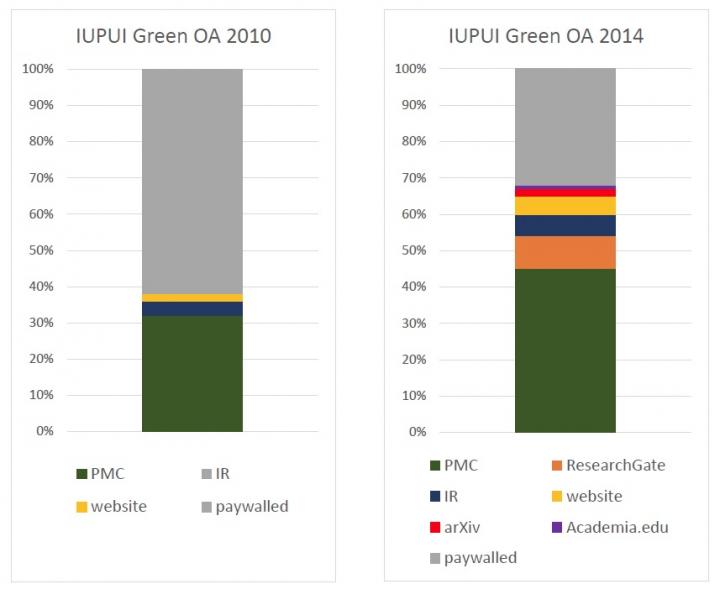Green open access (OA) is the practice of providing free access to a scholarly work on a website with no paywalls. Ideally, the authors of these green OA works observe the terms of copyright policies while also depositing items in a library-supported institutional repository or a not-for-profit subject repository. When authors do this, it's called "self-archiving."
Libraries have been coaxing and cajoling authors to participate in green OA for more than a decade. At IUPUI the effort began as early as 2004 when the library launched the DSpace installation that eventually became the institutional repository, IUPUI ScholarWorks. Today IUPUI ScholarWorks provides open access to more than 11,000 articles, theses, chapters, working papers, reports, and conference proceedings. Many of these works, however, arrived in recent years -- in response, in large part, to IUPUI's faculty-adopted OA policy (October 7, 2014). But the growth of the repository is just one way of looking at the rise of green OA on a campus. It would be a mistake to point at an institutional repository (IR) as the sole measure of a successful or unsuccessful effort to promote a campus culture of green OA. The IR is not the only the way to green OA -- nor is faculty self-archiving. There are many ways for a work to land on a no-paywall-website that is not owned by the publisher. In fact, I'm willing to bet that most authors know how to post a file on the internet. And, I even think that most authors know that they and their readers have a lot to gain by making a free version available ... somewhere, somehow. For that reason, library-supported scholarly communications programs need a more inclusive metric of green OA growth -- one that looks beyond the IR.
That’s why I'm working on a way to track a university's green OA growth. The basics steps include: 1) fetch a list of publications in any given year, 2) search the internet for green versions, 3) record the date the work was made available by green OA, and 4) do the math to get a green OA quotient. But, of course, the first three steps are riddled with contingencies, missing data points, and sheer tedium. Nonetheless, I think I'm making good progress and I plan to share a detailed description of the method later this year or early next year.
Although I'm still removing the wrinkles from my methods, I do have two data sets that I want to release. I'm confident in the results and happy to say that green OA is growing at IUPUI in more ways than one. These datasets include 100 randomly selected articles by IUPUI authors. The first includes articles published in 2010 (http://dx.doi.org/10.7912/D2CC7J); the second includes articles published in 2014 (http://dx.doi.org/10.7912/D27P48). Using Google Scholar, I searched for each article by title and opened all green OA versions of each article to identify the year it was uploaded. If it was clear that the article had been made available by green OA, I marked the item as "green" and recorded year the first green OA source to have shared it and the year that it was uploaded. Authors may "self-archive" works many years after they are published, so I used the year uploaded as a measure of green OA immediacy. Most articles (80% by one estimate) may be legally made green OA within one year of publication. For that reason, I decided that my green OA quotient should track the number of articles made OA within one year of the publication year. For example, to be counted as green OA in my 2010 data set, a work would need to be openly archived before the end of 2011. I recorded works uploaded after 2011 as "green," but I didn't count them in my analysis as green. I followed the same approach for the 100 randomly selected IUPUI articles published in 2014 -- if an article was made freely available on an OA website before the end of 2015, I counted it as "green."

The results of coding these two samples show a rapid increase in green OA at IUPUI. The green OA quotient nearly doubled, from .38 to .69. This increase, in large part, reflects compliance with the NIH Public Access policy. At the same time, authors and others are finding a variety of ways to make their works green OA.
As I refine my methods, I plan to conduct similar analyses for every year following 2010. Ultimately, I hope to have a way to track green OA trends at IUPUI and an approach that could be used at any institution to do the same. Until then, I’m happy to say that it looks like green OA is growing.
